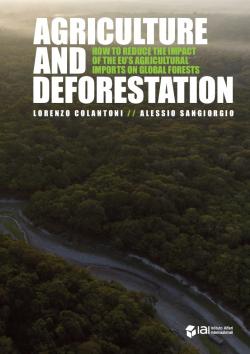Agriculture and Deforestation. How to Reduce the Impact of the EU’s Agricultural Imports on Global Forests
This report analyses the impact of EU agricultural imports on global forests, discussing and proposing technical, operative, policy and financial solutions to reduce this impact. It focuses on the seven commodities considered by the EU Regulation for Deforestation-Free Products (cattle, cocoa, coffee, oil palm, rubber, soya and wood) and dedicates particular attention to the Regulation. The report is divided in three parts: an overview, detailing the magnitude of EU imports and comparing it to other players; a technological and operative chapter, focusing on solutions ranging from tracing and certifications to enforcement and best agricultural practices; and finally a policy and private sector chapter, dedicated to EU and non-EU policies and to financial options. The report considers all trading partners of the EU globally, giving however specific attention to South-East Asia and South America, and to Indonesia and Brazil as main trading partners for agricultural commodities.
-
Details
Rome, IAI, April 2024, 112 p.
Introduction
Acknowledgments
Executive Summary
Policy recommendations
1. Overview: The role of agriculture, the EU and main players in global deforestation
1.1 Agriculture as the main driver of deforestation, and regional differences
1.2 Comparative analysis between the EU, United States, China, Japan and India
2. Technical and operative solutions
2.1 Best agricultural practices
2.2 Traceability
2.3 Standards and certifications
2.4 Enforcement
2.5 Smallholders, communities and indigenous people
2.6 Case study: Indonesia, monitoring forest fires in palm oil plantations in Riau and East Kalimantan
2.7 Case study: Brazil, EUDR and coffee production in Southern Minas Gerais
3. Policy and financial solutions
3.1 International attention and challenges to implementing solutions
3.2 UN
3.3 US, China and other countries
3.4 EU
3.5 Focus EUDR
3.6 Green finance and instruments for the private sector
3.7 Derisking strategies in agricultural supply chains
3.8 Other tools for the private sector
3.9 Case study: Brazil, sustainable logging in the Tapajos forest
3.10 Case study: Indonesia, coffee production near the Bukit Barisan Selatan National Park
4. References
4.1 Interviews
4.2 Bibliography
Notes



